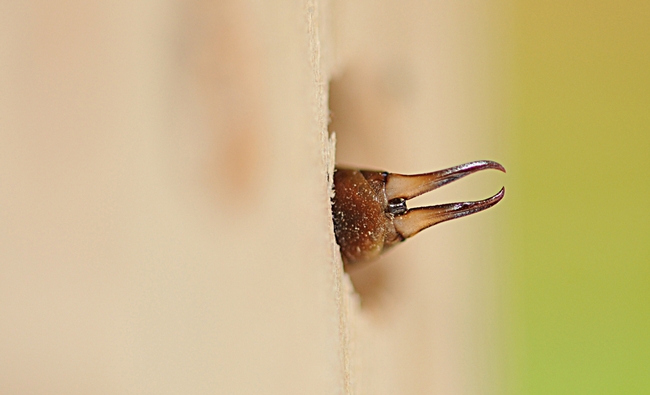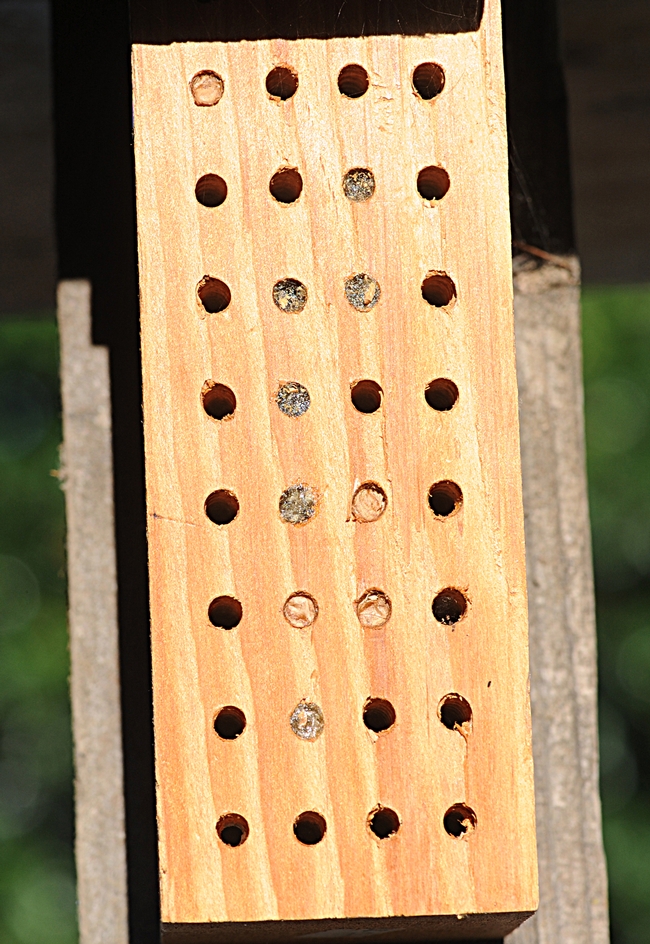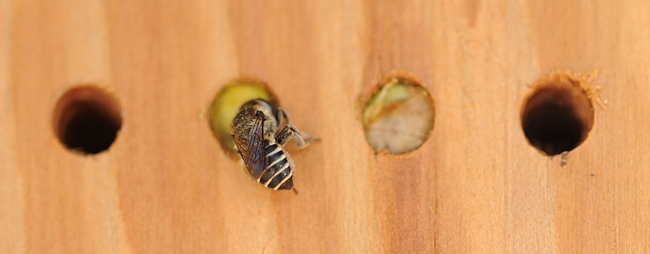- Author: Kathy Keatley Garvey
Ah, Saturday, April 17. It's the 107th Annual UC Davis Picnic Day! What's a picnic without bugs?
This year's event, all virtual, is themed "Discovering Silver Linings," and you can do just that by watching the pre-recorded videos and by participating in the Zoom sessions. Check out the Picnic Day schedule of events which include entomological exhibits and talks from the UC Davis Department of Entomology and Nematology, Bohart Museum of Entomology and the UC Davis Graduate Student Association.
New additions to the line-up (featured on the Bohart Museum of Entomology website), involve what you could call "The good, the bad and the bugly." Blue orchard bees, tsetse flies and mosquitoes are spotlighted in UC Davis research-based videos created by KQED's Deep Look series and presented by PBS Digital Studios. Each runs about four minutes.
Here are the KQED productions:
- Watch this Bee Build Her Bee-Jeweled Nest, featuring blue orchard bees, the project of UC Davis doctoral student Clara Stuligross.
- A Tsetse Fly Births One Enormous Milk-Fed Baby, showcasing the work of medical entomologist Geoffrey Attardo, assistant professor, UC Davis Department of Entomology and Nematology.
- This Dangerous Mosquito Lays Her Armored Eggs--in Your House, involving the Aedes aegypti mosquitoes that the Attardo lab studies.
Clara Stuligross, Doctoral Student
They exposed the bees to the neonicotinoid insecticide imidacloprid, widely used in agriculture, and found that the combined threats—imidacloprid exposure and the loss of flowering plants—reduced the bee's reproduction by 57 percent, resulting in fewer female offspring.
Other scientists have conducted similar research on honey bees, but this is the first comparable research on wild bees in field or semi-field conditions. The blue orchard bee, nicknamed BOB, is a dark metallic mason bee, smaller than a honey bee. It is prized for pollinating almond, apple, plum, pear, and peach trees. California almond growers often set up bee boxes or "bee condos" for blue orchard bees to aid in honey bee pollination. In the wild, the bees nest in reeds or natural holes.
Update? "We are currently working on a follow-up study to investigate potential carryover effects of past insecticide exposure on the same bee population, as well as how repeated pesticide exposure over multiple years impacts bee population growth," Stuligross said today.
Geoffrey Attardo, Medical Entomologist-Geneticist 
What many people do not know: "Female tsetse flies carry their young in an adapted uterus for the entirety of their immature development and provide their complete nutritional requirements via the synthesis and secretion of a milk like substance," Attardo says.
Attardo led landmark research published Sept. 2, 2019 in the journal Genome Biology that provides new insight into the genomics of the tsetse fly. The researchers compared and analyzed the genomes of six species of tsetse flies. Their research could lead to better insights into disease prevention and control.
The Deep Look episode on mosquitoes, "This Dangerous Mosquito Lays Her Armored Eggs-- in Your House," deals with the ability of Aedes aegypti eggs to survive out of water. Wrote the producers: "The Aedes aegypti mosquito, which can transmit dengue fever and Zika, makes a meal of us around our homes. And her eggs are hardy. They can dry out, but remain alive for months, waiting for a little water so they can hatch into squiggly larvae."
- Author: Kathy Keatley Garvey
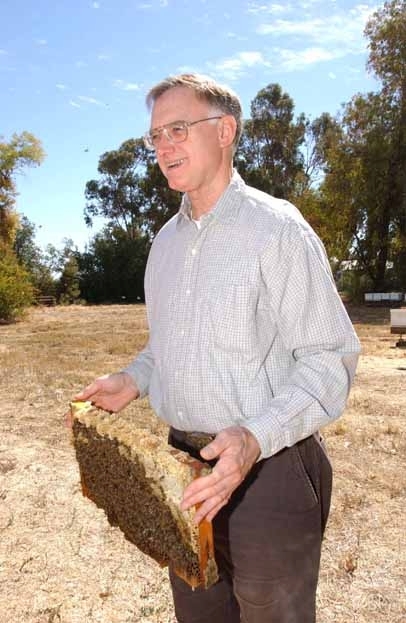
And it's definitely not a good time to be a honey bee.
The wind-whipped storms that are ravaging California are wreaking havoc on the state's almond pollination season, says honey bee guru Eric Mussen, Extension apiculturist emeritus, UC Davis Department of Entomology and Nematology, and president of the Western Apicultural Society.
The situation: California's million acres of almonds require two hives per acre for pollination. Without bees, no almonds.
Honey bees usually fly when temperatures reach around 55 degrees. During inclement weather, they hole up inside their hives. They're so unlike our postal workers who vow that “neither rain, nor snow, nor sleet” can stop mail delivery. Unfavorable weather for bees? Think "no-fly zone."
Mussen, California's Extension apiculturist for 38 years before retiring in 2014, continues to maintain an office in Briggs Hall, UC Davis, and respond to inquiries about honey bees. Not one to say "no," Mussen is serving a sixth term as president of the Western Apicultural Society (WAS), which was founded at UC Davis and gearing up for its 40th anniversary meeting Sept. 5-8 Davis.
And the steady rain we're having? How will that affect the pollination season?
“Rain," said Mussen, "is hard on the almond bloom for a few important reasons." He lists five reasons:
- Rain frequently is accompanied by cooler weather, which delays bloom. But, the delay can last only a short while, and then the flowers open and shed pollen, despite the weather. Honey bees usually neither forage on damp or wet blossoms, nor fly in the rain.
- If pollen grains come into contact with water, the water enters the openings in the pollen grains, through which the pollen tubes are supposed to emerge. The water is absorbed by the living protoplasm in the pollen grain and bursts its contents.
- Free water tends to transport spores of fungal, and sometimes bacterial, diseases to open flowers. Those microbes can invade the floral tissues, or in some cases, begin a journey through the flowers into the branches of the tree. When rain is imminent, growers usually will apply a fungicide to their trees to reduce the amount of infection. Frequent rains can promote multiple pesticide applications.
- By almond bloom time, honey bee colonies are collecting as much pollen as they can find, to feed an expanding brood nest. A prolonged period of inclement weather will interfere with nectar and pollen foraging, and leave little food to raise be brood. Lack of incoming pollens can reduce brood rearing, sometimes even to the point of the adult workers consuming most of the younger brood to save the nutrients for better times.
- Beekeepers who are used to seeing their colonies increase from 8-10 frames of bees to 10-12 frames during almond bloom may be disappointed this year due to a situation that is beyond their control. Providing supplemental feed can help their bees to a limited extent, but we have no supplemental feed that matches the nutritional value of mixed pollens.
Mussen says that native, solitary bee species, such as the blue orchard bee, also can be impacted negatively by continuous wet weather. “Foraging flight is curtailed, pollens and nectars are diluted or washed away, nesting sites can be flooded, and preferred or required floral sources may not be available that year,” he said. “This can have substantial negative impacts on the size of the following generation.”
Bottom line: it's not a good time for almond growers, beekeepers, and bees.
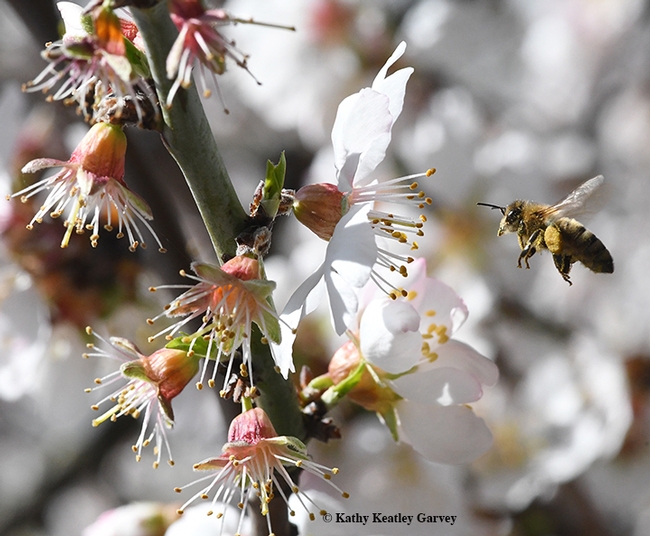
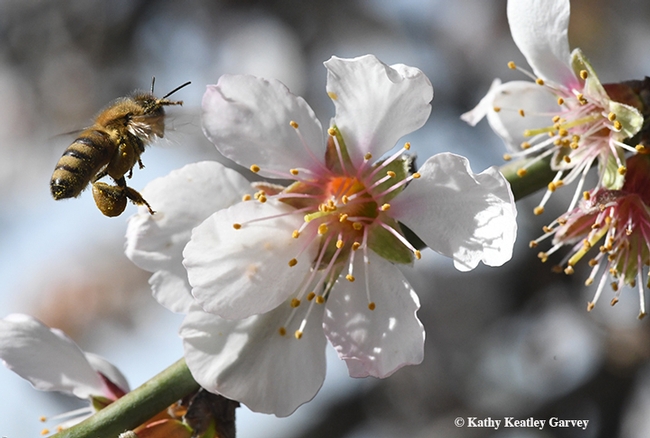
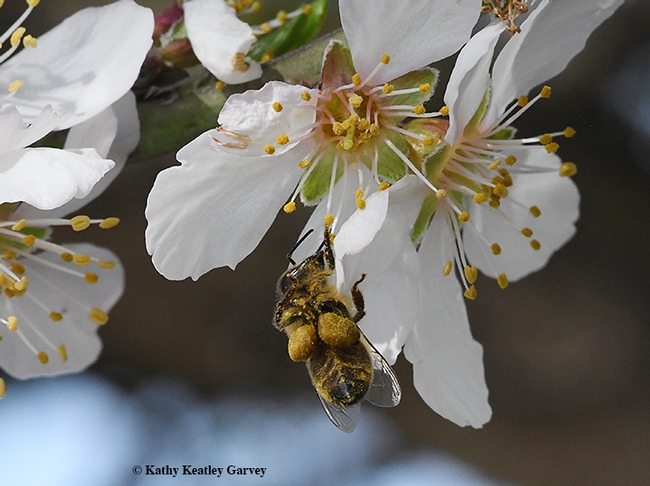
- Author: Kathy Keatley Garvey

"Go native" with native bees, that is.
Many folks are building or buying bee condos to provide nesting sites for blue orchard bees (Osmia lignaria) and leafcutting bees (Megachile spp.).
A bee condo is a block of wood drilled with specially sized holes for nesting sites. Bees lay their eggs, provision the nests, and then plug the holes. Months later, the offspring will emerge.
In our backyard, we provide bee condos for BOBs (short for blue orchard bee) and leafcutter bees.
In the summer it's fun watching the leafcutter bees snip leaves from our shrubbery and carry them back to their bee condo. It's easy to tell the nesting sites apart: BOB holes are larger and plugged with mud, while the leafcutter bee holes are smaller and plugged with leaves.
Osmia lignaria, a native species of North America, is sold commercially for use in orchard crop pollination.
At the Bohart Museum of Entomology Open House on Sunday, March 2, native pollinator specialist Robbin Thorp, UC Davis emeritus professor of entomology, displayed a variety of bee houses.
If you want to learn how to build them or where to buy them, Thorp has kindly provided a list of native bee nesting site resources on the Harry H. Laidlaw Jr. Honey Bee Research Facility website. You can also purchase them at many beekeeping supply stores. (Also check out the Xerces Society's website information.)
Better yet, if you'd like to learn more about native bees and their needs, be sure to register online for the Pollinator Gardening Workshop on Saturday, March 15 on the UC Davis campus. Hosted by the California Center for Urban Horticulture, it begins at 7:30 a.m. in Room 1001 of Giedt Hall and ends at 2 p.m. with a plant sale at the UC Davis Arboretum Teaching Nursery and a tour of the Häagen-Dazs Honey Bee Haven, a half-acre bee friendly garden on Bee Biology Road, west of the central campus. For the small fee of $40 you'll receive a continental breakfast and box lunch and return home with an unbee-lievable wealth of knowledge. Speakers will include several honey bee and native bee experts: native pollinator specialist Robbin Thorp; pollination ecologist Neal Williams and Extension apiculturist Eric Mussen. See the complete list on the website.
You'll be hearing from Robbin, Neal and Eric, but you'll be thinking about BOB.

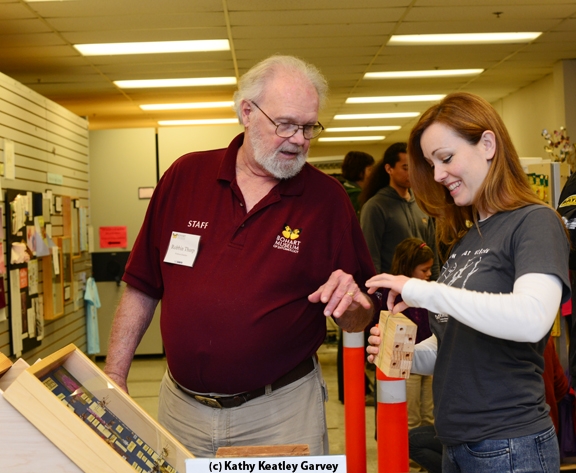

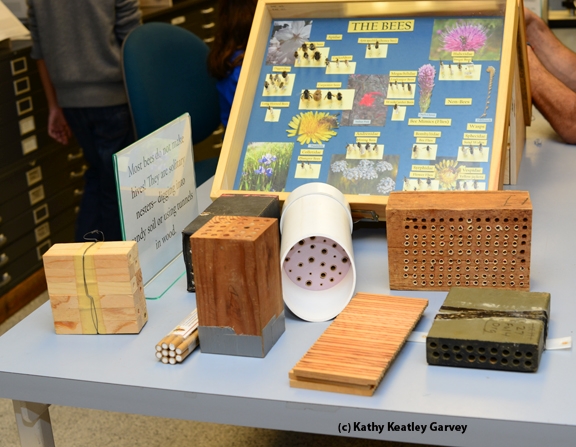
- Author: Kathy Keatley Garvey
When you install bee condos--those wooden blocks with holes drilled in them to attract nesting native bees--sometimes you get the unexpected.
Like earwigs!
Home invasion! Home invasion!
We installed two bee condos, each about the size of a brick, in our yard. One is for leafcutting bees (genus Megachile) and is filled quite nicely, thank you, with 10 tenants. Another, with larger holes, is for blue orchard bees (BOBs, genus Osmia). Despite our "vacancy" sign (discounted rates, free WiFi, free continental breakfasts), nothing is occupying it except earwigs.
Earwigs! We're wigged out.
They were especially persistent in the damp weather.
Native bee guru Robbin Thorp, a native pollinator specialist and emeritus professor of entomology at the University of California, Davis, who has researched native bee holes with colleagues John Barthell and Gordon Frankie, told us: "We found that mostly wasps and earwigs occupied the largest holes. Only a few of the introduced leafcutting bees that could not find appropriate size holes when bee populations were abnormally high would make aberrant nests in the larger cavities. By 1990, we scaled back to the three diameters that our bees use: 4.5, 6.5 and 8 mm (3/16, 1/4, and 5/16 inch) for our studies in California."
The earwigs, Thorp says, "are not so likely to be present now that the weather is hot and dry, but in shady, damp, cool areas, and especially early in the year when it is wet and cool, they can be a problem."
Their research, published in Environmental Entomology in 1998 and titled “Invader Effects in a Community of Cavity Nesting Megachilid Bees (Hymenoptera: Megachilidae)” involved native bee species and their introduced competitors.
Like earwigs.
In their paper, they wrote that the European earwig (Forficttla auricularia L) from Eurasia and northern Africa, was introduced into North America at the turn of the century. "It has invaded most counties in the state of California since its apparent introduction in the late 1910s (Essig 1923, Langston and Powel! 1975)," they wrote. "Its populations have grown to high numbers in natural areas, especially in riparian zones where humidity levels are relatively high (Barthel! and Stone 1995). The earwig is most active during evening hours, climbing into tree crowns to scavenge and hunt but hiding in cracks, crevices, or holes during the daylight hours."
Active indeed. Those European earwigs soon found our condo for BOBs (which perhaps should now mean Big ol' Blast).
